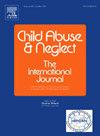Effectiveness of Nurse-Family Partnership on child outcomes by patterns of program intensity: Secondary evidence from a randomized controlled trial (British Columbia Healthy Connections Project)
IF 3.4
2区 心理学
Q1 FAMILY STUDIES
引用次数: 0
Abstract
Background
Nurse-Family Partnership's (NFP's) effectiveness at improving child outcomes is likely influenced by patterns of program provision and engagement, or ‘intensity’.
Objective
To investigate program effectiveness by patterns of intensity.
Participants and setting
We analyzed secondary data from the Canadian NFP randomized controlled trial (RCT) involving 739 maternal participants and their 737 children in British Columbia.
Methods
Participants were randomly allocated 1:1 to NFP and existing services (n = 368) or existing services (n = 371). We collected data on child injuries, language, cognition and problem behavior (mental health) at age two years (by November 2019). We estimated principal causal effects (PCE) using propensity score (PS) methods.
Results
We identified three NFP intensity patterns: Low (median [Mdn] 14 visits), Partial (Mdn 52) and Sustained (Mdn 83). For NFP participants, we found statistically-significant differences in group mean scores (mean M [SD]): for Sustained on observed language (NFP 94.55 [16.71] versus PS-matched controls 89.97 [16.76]; PCE = 5.8, 95 % CI 0.57, 11.03, p = 0.030) and problem behavior (NFP 51.33 [9.04] versus PS-matched controls 56.43 [9.38]; PCE = -5.10, 95 % CI -8.27, −1.93, p = 0.002); and for Partial on maternal-reported language (NFP 313.43 [200.36]) versus PS-matched controls (255.99 [183.56]; PCE = 65.05, 95 % CI 24.09, 106.00, p = 0.013).
Conclusions
Delivering NFP as intended, with sustained intensity, led to greater benefits regarding child language and problem behavior (mental health) but not cognition or injuries by age two years. These complementary analyses provide crucial information, beyond standard RCT analyses, on NFP's effectiveness in this Canadian cohort. Our results highlight the importance of ensuring full NFP intensity to maximize program benefits for children.
护理-家庭伙伴关系对项目强度模式下儿童结局的影响:来自随机对照试验的辅助证据(不列颠哥伦比亚省健康联系项目)
护士-家庭伙伴关系(NFP)在改善儿童结果方面的有效性可能受到项目提供和参与模式或“强度”的影响。目的探讨项目强度模式的有效性。我们分析了来自加拿大NFP随机对照试验(RCT)的次要数据,该试验涉及不列颠哥伦比亚省的739名母亲和她们的737名子女。方法将参与者按1:1的比例随机分配到NFP和现有服务(n = 368)或现有服务(n = 371)。我们收集了两岁(截至2019年11月)儿童伤害、语言、认知和问题行为(心理健康)的数据。我们使用倾向评分(PS)方法估计主因果效应(PCE)。结果我们确定了三种NFP强度模式:低(中位数[Mdn] 14次),部分(Mdn 52次)和持续(Mdn 83次)。对于NFP参与者,我们发现组平均得分(mean M [SD])具有统计学意义:对于持续观察语言(NFP为94.55[16.71],而ps匹配的对照组为89.97 [16.76];PCE = 5.8, 95% CI 0.57, 11.03, p = 0.030)和问题行为(NFP为51.33 [9.04],ps匹配对照组为56.43 [9.38];PCE = -5.10, 95% CI = -8.27, - 1.93, p = 0.002);在母亲报告的语言部分(NFP 313.43[200.36])和ps匹配的对照组(255.99 [183.56]);PCE = 65.05, 95% CI 24.09, 106.00, p = 0.013)。结论:按预期提供持续强度的NFP,对儿童的语言和问题行为(心理健康)有更大的好处,但对两岁时的认知或伤害没有好处。除了标准的RCT分析,这些补充分析提供了关于NFP在加拿大队列中的有效性的重要信息。我们的研究结果强调了确保充分的NFP强度以最大限度地提高项目对儿童的好处的重要性。
本文章由计算机程序翻译,如有差异,请以英文原文为准。
求助全文
约1分钟内获得全文
求助全文
来源期刊

Child Abuse & Neglect
Multiple-
CiteScore
7.40
自引率
10.40%
发文量
397
期刊介绍:
Official Publication of the International Society for Prevention of Child Abuse and Neglect. Child Abuse & Neglect The International Journal, provides an international, multidisciplinary forum on all aspects of child abuse and neglect, with special emphasis on prevention and treatment; the scope extends further to all those aspects of life which either favor or hinder child development. While contributions will primarily be from the fields of psychology, psychiatry, social work, medicine, nursing, law enforcement, legislature, education, and anthropology, the Journal encourages the concerned lay individual and child-oriented advocate organizations to contribute.
 求助内容:
求助内容: 应助结果提醒方式:
应助结果提醒方式:


